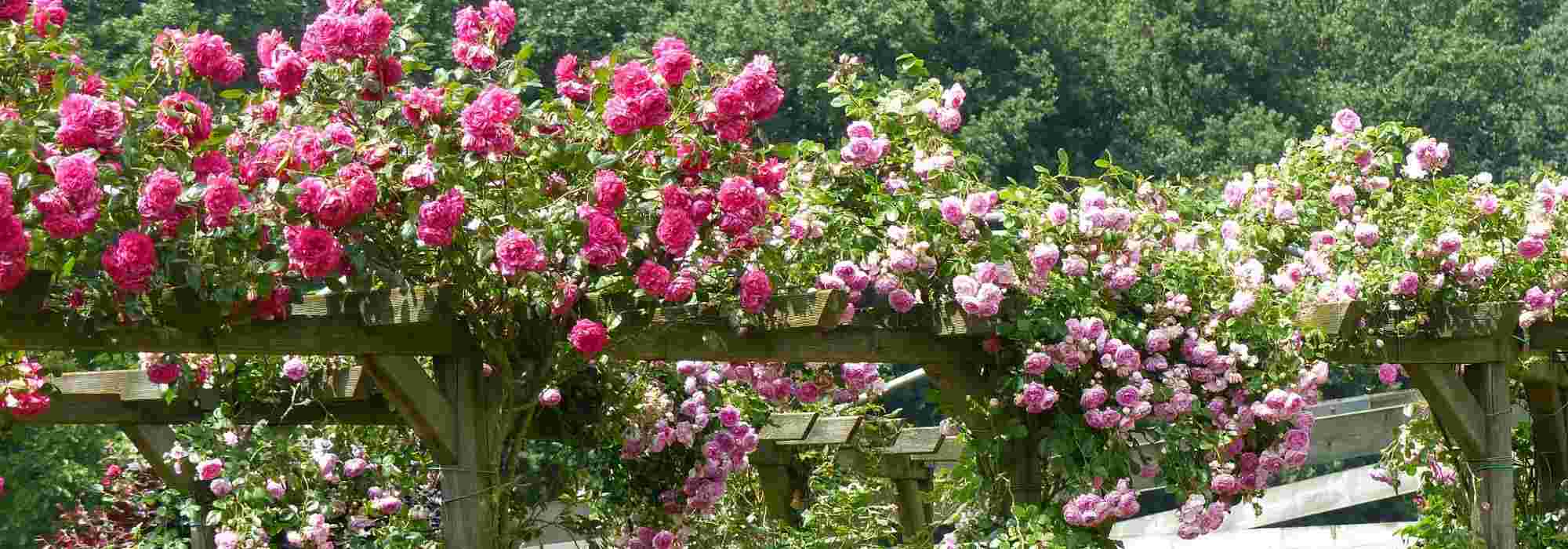
When to prune a climbing rose and how to do it properly?
The right actions
Contents
Pruning climbing roses is an essential action to ensure their vigour, abundant flowering, and longevity. These roses, whether repeat flowering or not, develop long floriferous stems capable of elegantly covering a wall, pergola, arch, pillar, or even a tree. They can reach heights of up to 3.5 to 4 m. To maintain a balanced shape, good health, and continued flowering year after year, pruning of the climbing rose is necessary each year.
Discover our tips on when and how to prune a climbing rose!
Good to know: some variety names are followed by the term “climbing”, a straightforward translation of “grimpant” in English.
When to prune a climbing rose?
Climbing roses are pruned at specific times, depending on their ability to repeat flower within the year or not:
- repeat flowering climbing roses: the roses form on the shoots that have developed in the year. Pruning of the climbing rose is therefore done at the end of winter, when vegetation resumes, between February and April depending on the regions. It is also possible to carry out a light pruning in autumn to ease the workload in spring.
- non-repeat flowering climbing roses: they bear flowers on branches that are 2 years old. So if you prune them at the end of winter, you remove the shoots formed the previous year that are ready to flower. Pruning should therefore be done just after flowering, that is, in July or August, unless you want to enjoy the beautiful hips.
To learn more about the pruning periods for roses, I invite you to consult our article: “When to prune roses“?
Good to know: pruning of climbing roses only concerns well-established plants, at least three years old.

A climbing rose against a wall
How to prune a repeat flowering climbing rose?
A repeat flowering climbing rose blooms on the current year’s shoots as well as on older branches throughout the season.
Here are our tips for properly pruning your rose:
- start by equipping yourself with thick gloves that cover your forearms;
- remove dead branches and old wood;
- thin out and then cut back branches aged 3 years or more to stimulate the formation of new floriferous shoots from the base. Cut in sections of about thirty centimetres at a time, from the tip to the base of the branch to make it easier. Don’t hesitate to use loppers to remove these branches as low as possible since the wood is hard and very difficult to cut with simple pruning shears;
- aim to keep between 3 and 6 vigorous and healthy main branches;
- train the younger main branches you have kept and shorten all secondary shoots to leave only 3 to 15 cm. Cut at an angle, 0.5 cm just above a well-oriented bud. This technique is called fishbone pruning.
- on a wall or fence, fan out the main branches as horizontally as possible along wires or on a trellis, for example. This helps to distribute the sap well among the shoots. On an obelisk, wrap the stems around from the base of the rose. Training climbing roses is easier when the stems are young and flexible.
 Pruning a climbing rose[/caption>
Pruning a climbing rose[/caption>
Some examples of repeat flowering climbing roses: ‘Ghislaine de Féligonde’, ‘Phillis Bide’, ‘Clair Matin’, ‘Pierre de Ronsard’, ‘Guirlande d’Amour’, ‘Jasmina’, ‘Madame Alfred Carrière’, etc.
Discover other Climbing Roses
View all →Available in 2 sizes
Available in 1 sizes
Available in 2 sizes
Available in 2 sizes
Available in 3 sizes
Available in 2 sizes
Available in 3 sizes
Available in 2 sizes
Available in 2 sizes
How to prune a non-repeat flowering climbing rose?
Non-repeat flowering roses are roses that bloom abundantly in June/July. The flowering typically lasts between 3 and 4 weeks.
Here’s how to prune non-repeat flowering climbing roses:
- remove dead wood and old branches at the base to encourage the appearance of new shoots;
- simply shorten the branching and take the opportunity to rebalance the shape of the rose if necessary;
- check the attachment points of the rose on the support and train the new shoots as they develop, without tightening the ties too much.
Some examples of non-repeat flowering climbing roses include ‘May Queen’, ‘Alchymist’, ‘Aimée Vibert’…
Finally, if you want to enjoy the decorative fruits, I recommend simply removing the oldest branches and postponing the pruning of your climbing rose until later, at the end of winter. You can just shorten the stems that have already bloomed and rejuvenate the framework of the rose. But above all, do not touch the beautiful shoots from the previous year. They are the ones that will bloom in June!
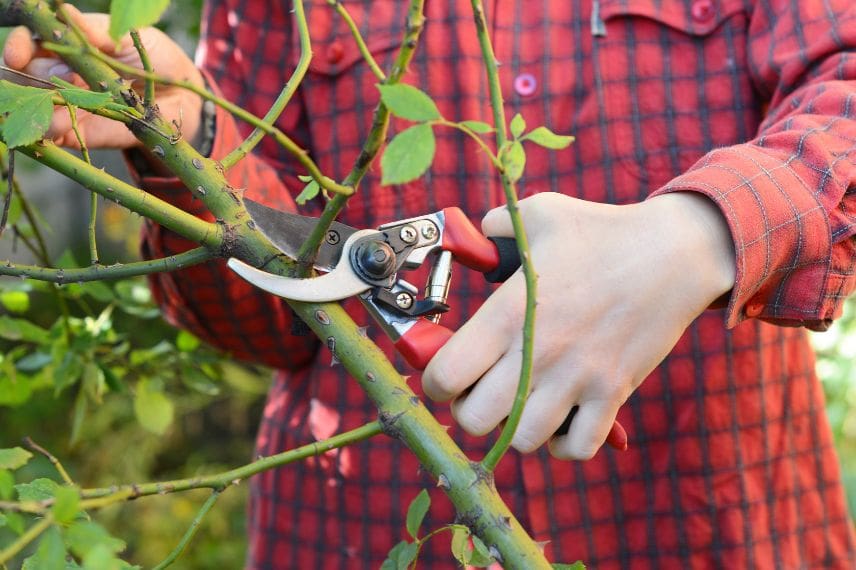 Pruning a non-repeat flowering rose with pruning shears</caption]
Pruning a non-repeat flowering rose with pruning shears</caption]
Read also
Climbing roses: the 10 best varietiesAfter pruning: care and training of climbing roses
After pruning, there are a few actions you can take to maintain your climbing rose:
-
Weed and aerate the soil at the base of the rose by removing unwanted herbs and lightly scratching the surface to improve aeration and water infiltration.
-
Add an organic amendment such as well-rotted compost or manure to enhance soil fertility before the vegetation resumes.
-
Install natural mulch (wood chip, bark, dead leaves, etc.) to retain moisture, suppress the growth of unwanted herbs, and protect the shallow roots from temperature fluctuations (both heat and frost).
-
Check the ties on the support, ensuring they are flexible, non-damaging, and spaced adequately to allow young shoots to develop without constraint.
-
Train the climbing rose by tying the young, flexible stems horizontally or in a fan shape, which encourages the appearance of flower buds along their length, unlike a vertical shoot that flowers less.
-
Carry out a preventive treatment in case of mild winters or humid climates, using Bordeaux mixture or a natural fungicide to limit the risks of powdery mildew, rust, or black spots.
- Subscribe!
- Contents




































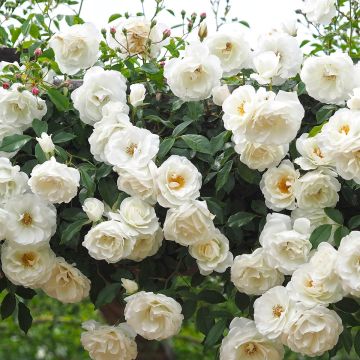


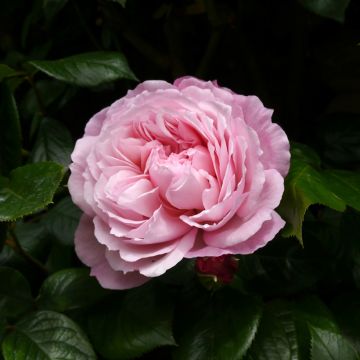

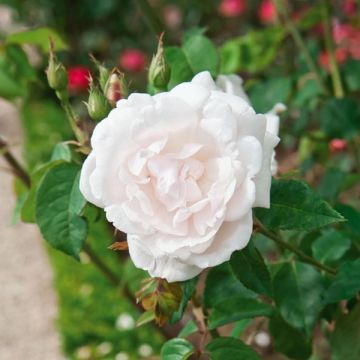
Comments